There’s a concept relating to electric cars that I think makes a lot of sense — a concept that I’ve discussed, and one that non-idiots, like automotive designer Henrik Fisker, have discussed. The concept is that when it comes to EVs, which all generally have the same set of driving characteristics thanks to the nature of electric motors – great torque from the get-go, smoothness, silence, no jerks from shifting and so on – the other characteristics of a car, especially styling, become increasingly important. The new 2024 Hyundai Ioniq 6 is a great demonstration of this concept. It’s an EV that stands out less for the way that it drives and more because of traits like striking styling, a cool user interface and experience, and clever space utilization. Sure, there’s plenty of other important traits, but overall I think the Ioniq 6 is a great case study in an automaker doing a good job of paying attention to what seem to be the qualities of a car that are important to lots of people, and then, you know, building that car. So let’s talk about “that car.”
Actually, if you’d prefer a short sorta-synopsis on video, I have you covered, too:
How To Evaluate An Electric Car Like This
Well, perhaps before we dive into the specifics of the Ioniq 6, let’s look at exactly what Fisker had to say about EVs, because, again, I think it’s very relevant here:
“Design is going to be increasingly important. When you move to electric vehicles, you’re not interacting anymore with a complex mechanical gasoline engine where the engine noise and response varies extremely from different car companies. So I think values from buyers in the future are going to shift.
“We’re all going to expect fast acceleration, instant torque that we have in acceleration – but we’re going to start looking at other ways to entice the buyer. Exterior and interior design. The user interface. The ride and handling.”
I’d add to this the all-important range number and the state of the recharging network available to the car. Oh, and space utilization and practicality. But, old Henrik is right: styling is incredibly important, because humans really, really care about the way things look. That’s why we have fashion and architecture and industrial design instead of just massively efficient factories churning out generic jumpsuits that we wear in our purely rectangular poured concrete buildings as we choke down nutrient bars that taste like unsalted drywall. We’re not coldly rational beings, we never will be, and I’m just fine with that.

This is the mindset I think we need to have when thinking about EVs like the Ioniq 6: The intangible and irrational qualities are extremely important, and we have to respect those, because we are intangible and irrational ourselves. Of course, cold, uncaring reality is still something we need to deal with, so don’t think I’m just ignoring all of that. With this in mind, I came away from my time with the Ioniq 6 feeling pretty good about the car. It’s not without its flaws, of course, but it’s also a pleasing object to interact with, a space to exist in, and a tool to use.

[Full Disclosure: Hyundai flew me out to Arizona and put me up in a hotel that smelled like rich people. The company fed me several times, plied me with alcohol, pretended to tolerate me as a person, and gave me access to engineers and designers. They also never did that thing where one person crouches down behind you while another person shoves you backwards, even though they had ample opportunities to do so. – JT]
The Ioniq 6 starts at $41,600 for the 149 horsepower, 240-mile range base RWD model, and can also be equipped as a RWD 225 hp model with 361 miles of range, or as a dual motor AWD sedan making 320 hp, topping out at over $52,000. We’ll go over all of this later, but let’s dig into my driving experience as much as we can first.
How The Car Looks In-Person

I’m going to talk about the design of the Ioniq 6 first because I think this is one of those cars where the styling is an extremely significant trait, because it’s distinctive and, sure, pretty polarizing. In fact, when I wrote about how the styling was at least partially inspired by the legendary Art Deco rear-engined bread loaf known as the Stout Scarab, I’ll admit I was surprised to find a large number of negative comments from our readers regarding the Ioniq 6’s design.
I like the look a great deal, but it’s clear that it’s not everyone’s fistful of chili. In part, I think that’s why I like it: It’s not boring. It’s an unexpectedly busy design, especially from certain angles like the rear three-quarter view, but again, I think that adds to its appeal. A lot of modern design elevates and idolizes ideas of purity of form and cleanliness, but the truth is sometimes having many things on which to focus can help give a car character.
I tend to think that’s at least partially why classic cars, with their large and varied congregations of chrome trim and horn grilles and stuck-on lighting units and creases and fins and vents and whatever, they tend to be things we can relate to emotionally — more so than the smoother, more integrated and more featureless forms that make up so many modern designs.
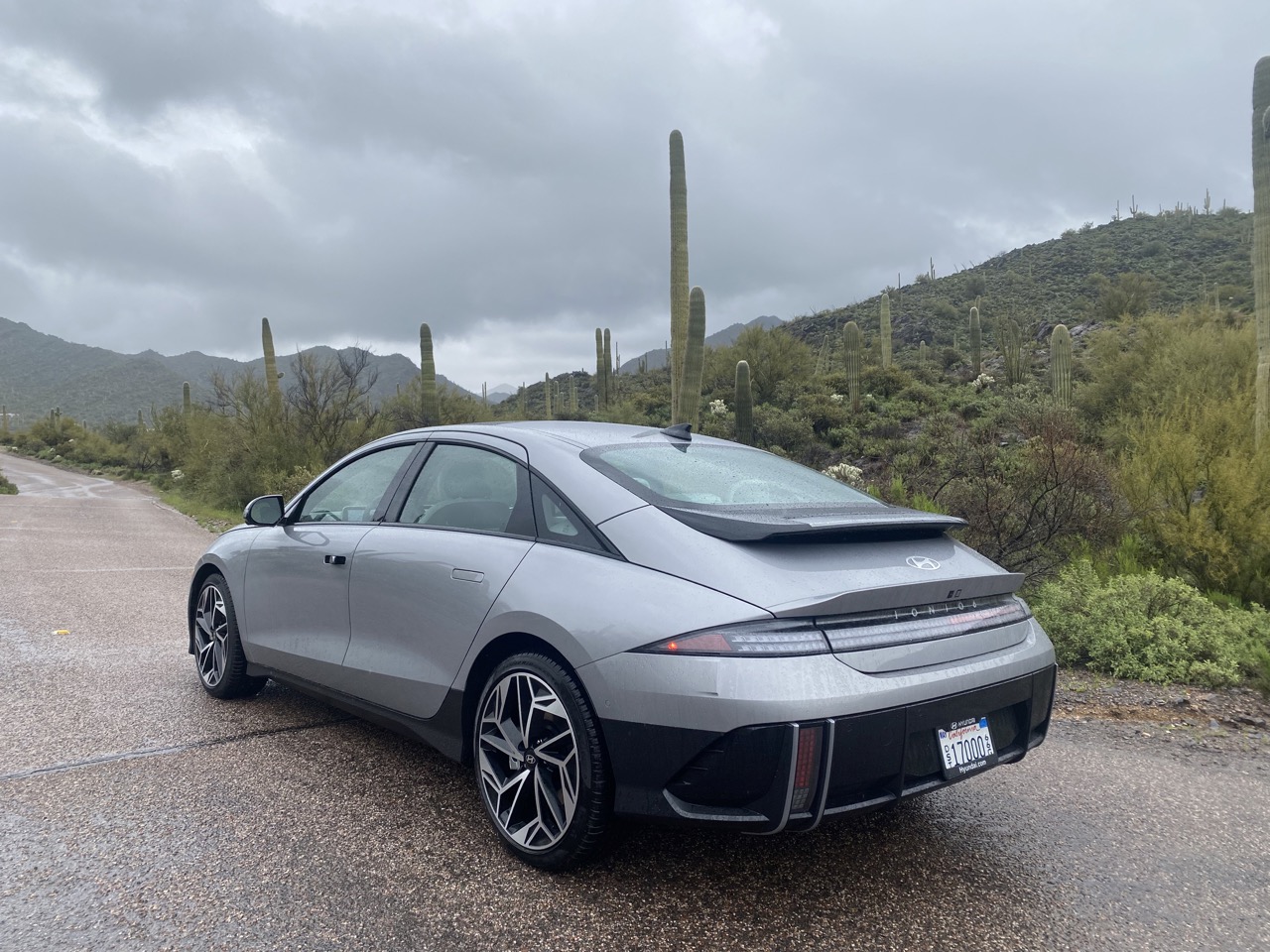
Just look at this angle of the Ioniq 6 here; there’s a hell of a lot going on. This is a car not afraid of its own shutlines and panel lines, and wears them almost like some kinds of geometric tattoos. The panel shapes and cutlines are carefully considered, like the one that continues the line of the wraparound heckblende taillight and continues into the wheelarch, dividing the rear quarter panel from the upper bumper skin. The bumper area has a lot going on, too, like the pair of vertical bumper guard-like units on either side that house the rear retroreflectors and reverse lamps. I can’t think of another modern car that has a bumper feature quite like this.
The rear is rounded, and perhaps even a bit droopy, reminding me, as I mentioned before, of the old Infiniti J30’s hindquarters:

This sort of rounded shape, popular in the early 2000s (think Audi TT, also) demands a spoiler to help keep it planted at speed, and where on older designs of this type those spoilers tended to look like tacked-on afterthoughts, it’s integrated well here. In fact, there’s that spoiler below and then a sort of wing above, incorporating the large third brake lamp and making the Ioniq 6 one of the few cars to come with dual rear spoilers/wings from the factory, like the Merkur XR4Ti:

I don’t think Hyundai was trying to pay homage to everyone’s favorite fancier Ford Sierra; I think the brand made these choices in order to get the best possible aerodynamic results that it could, and the team seems to have achieved that, with a drag coefficient of 0.21 — one of the best of any car currently built, and better than, say, the Tesla Model 3, which has a Cd of 0.23. That’s also why the car features some peculiar-seeming surface details, like this odd little sculpted rectilinear lump within and below the taillight:
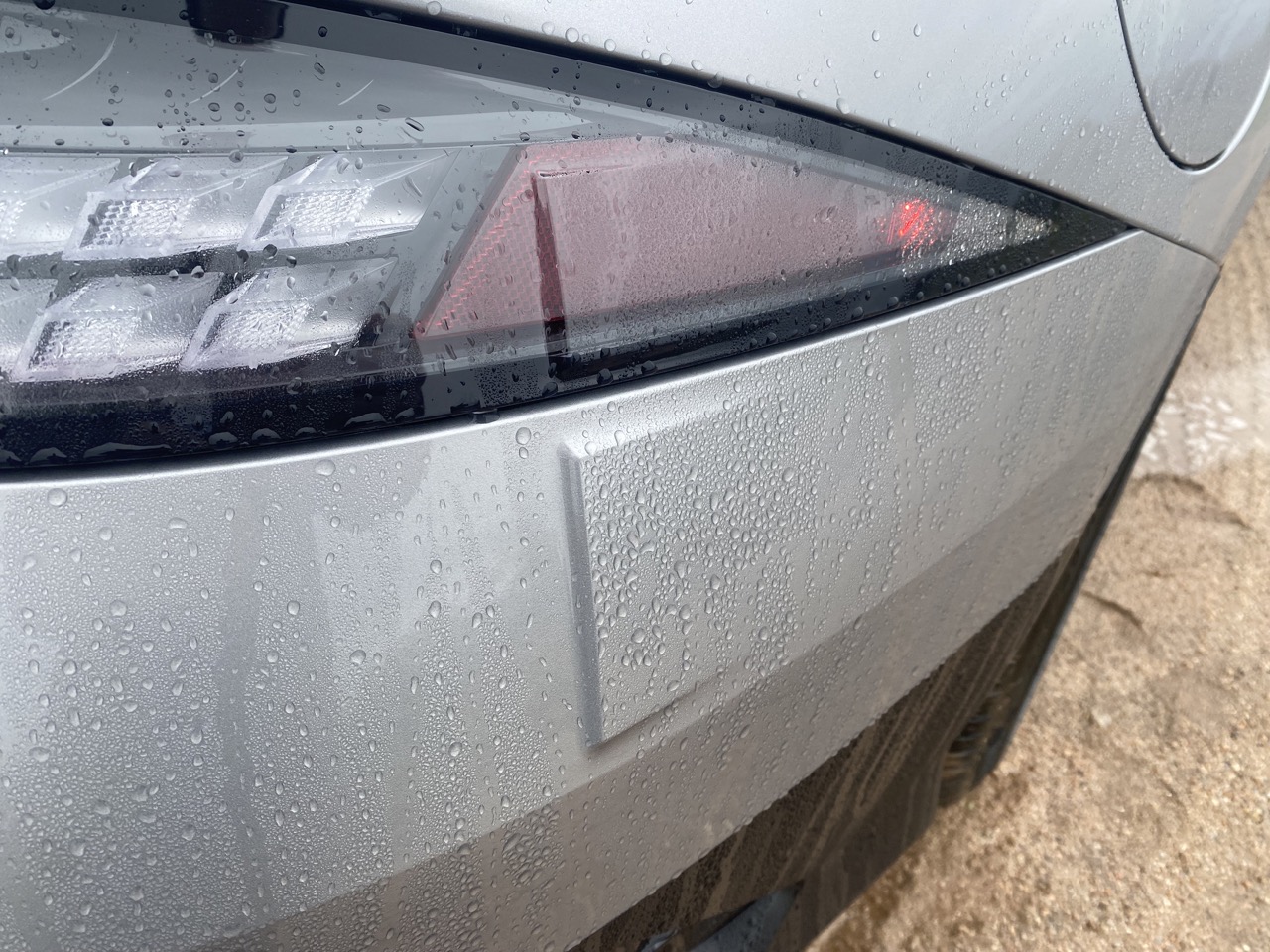
That’s an aero enabler, directing the wind away from the body at the rear of the car, which helps because of some aerodynamic explanation that has so much math in it that were you to try to explain it to me, I’m pretty sure a lone trickle of blood would drip out of my ear before my head fell heavily to the table, never to rise again.
Crap, now that I look at that little section I can’t not see, of all things, some Chevy Monza in there:

I mean, I always like the rear end of the Monza, so I can’t feel too bad about that. I just wasn’t expecting it.
I say all this because I want to be clear that the design of this car is not frivolous; there are aerodynamic reasons for much of it, but there is also a very clear design theme at work, playing a lot with the tension between the curvilinear large overarching forms and the smaller geometric details, which seem to be inspired by Hyundai’s Parametric Pixel design language. Here, look at some of the details in the lighting and other places:



Grids, squares, pixels, whatever you call them. It reminds me of not just pixel art but also the sort of detailing seen in the Postmodern movement, like the postmodern architectural icon Michael Graves’ 1982 Portland Building:

It’s probably also worth noting that this building is really controversial in the architecture world, with plenty of snobby architecture critics absolutely hating it. Plenty of people like it, too, so I think in that sense the Ioniq 6 feels like a distant relative.

Around front, the grille-less (there actually are air intakes under the front bumper there, hidden by the two panels to the left and right of those central six squares; yes, those panels are active shutters that open and close as needed) front end really evokes Porsches, though Hyundai design lead Hak Soo Ha insists that Porsches were not a design inspiration. I like the clean front end; it’s so much simpler than the rear, yet still not looking out of place.
In profile, I think the Ioniq 6 has some real presence. It looks sleek and not exactly futuristic, but almost retro-futuristic, like how we’d have imagined the future at some indeterminate time in the past:
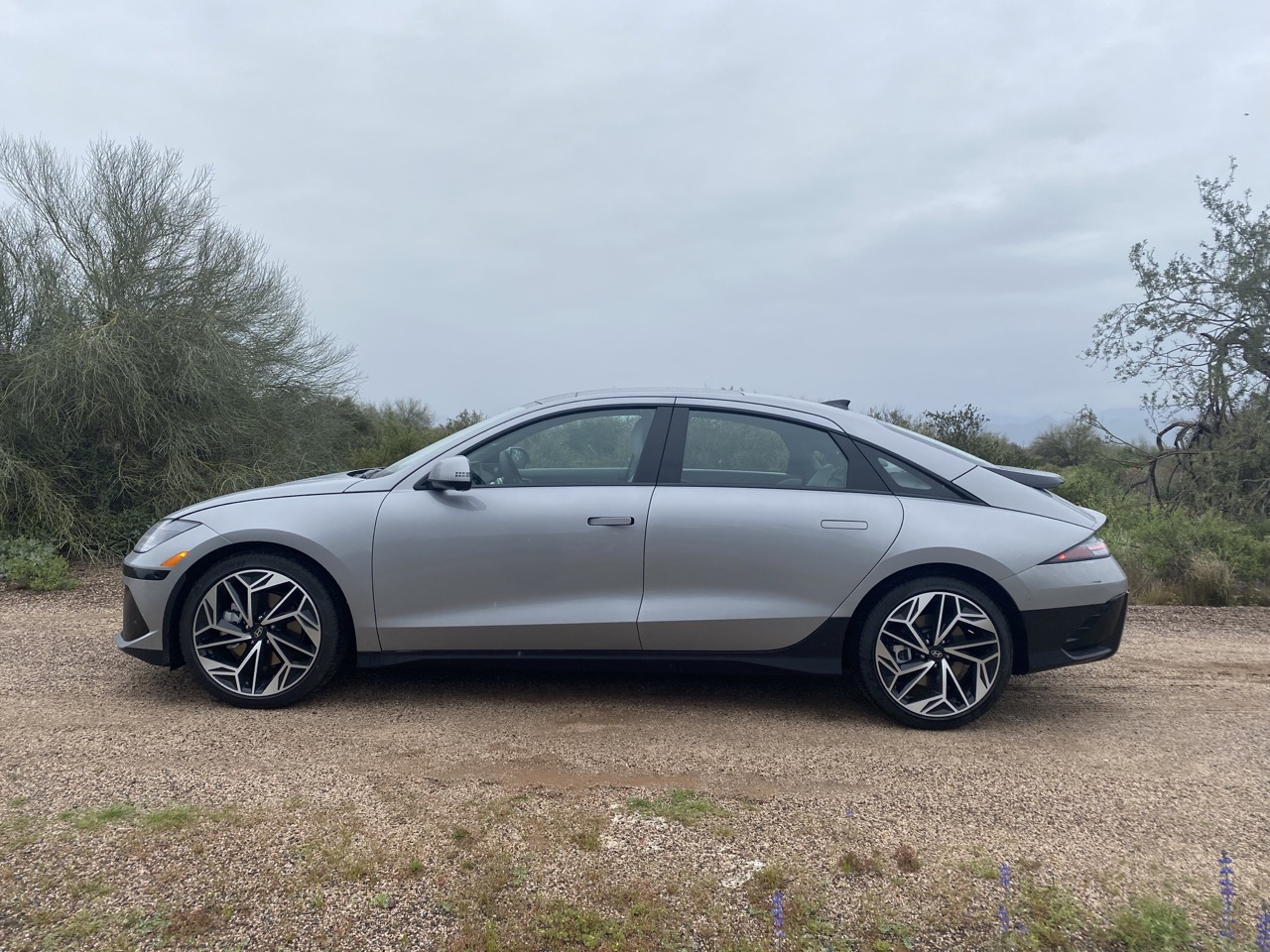
The challenge of designing an EV sedan as opposed to a crossover or SUV is that the nature of most EV platforms is that they are “skateboard”-like designs with the batteries built into the floor, which makes a very flexible and potentially space-efficient platform, but also one that has a relatively high floor height. This isn’t so much of a big deal for a crossover or SUV, but for a sedan that you’d like to be low and sleek, it’s tricky.
Hyundai pulled it off quite well, I think, and as a result the Ioniq 6 is taller than it looks, a nice bit of visual trickery. The lower black areas of the body help reduce the visual height, as does that curved inset character line, and I think the choice to let the rear door remain just body colored and cut into the black area is interesting.
It seems the there’s a way to get the Ioniq 6 with a sort of inverted color scheme, as I saw a black car that had light gray in place of the black lower areas, and it looked pretty striking:

I like those wheels, too, like a gleaming silver pizza flying apart. I’m glad Hyundai has this option for black cars, otherwise all the details would get swallowed up by darkness. Speaking of color, Hyundai seems to be doing a bit better than most of this chromatically cowardly industry, having at least three actual colors – a blue, red, and even a green – along with the usual white, silver, and black. Oh, and there’s a gold, too:

The Ioniq 6 will not get lost in your average Target parking lot. People will notice it. People will see it and their eyes will track it as you drive by, and opinions will form in their heads. They won’t all be positive opinions, but they won’t be boring ones, and I feel that’s high praise for an automobile.
Oh, you know what’s kind of a fun and odd little detail? This:
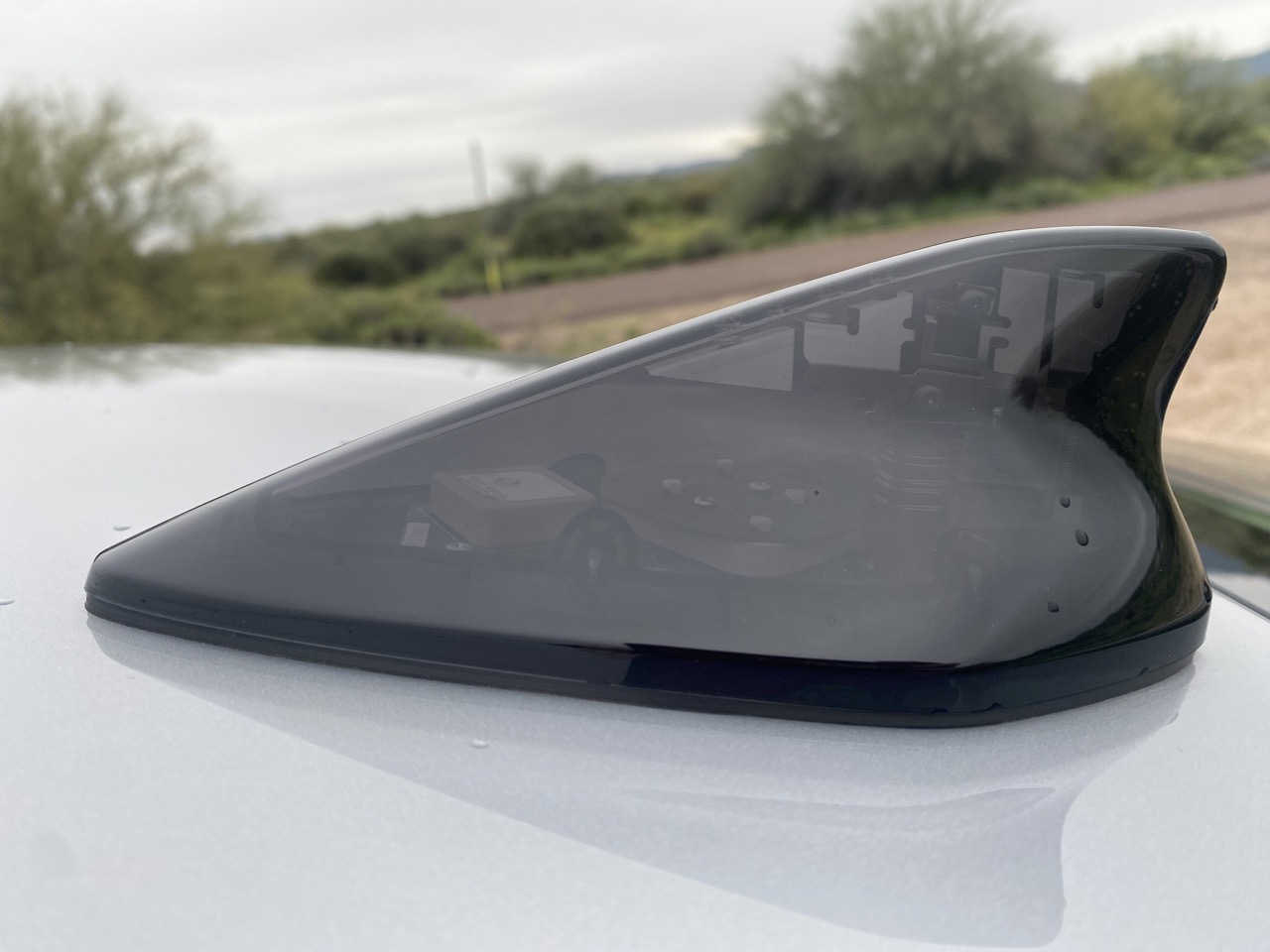
That’s the car’s antennae fin, on the roof, but the housing is transparent so you can see all the components inside. Neat!
Oh, while we’re on the roof already, I do think the glass roof area could have been larger. There are so many nearly-full glass roof options out there today, after all.

Anyway, let’s move into the cabin.
What I Thought Of The Interior

I liked the Ioniq 6’s interior a lot. It’s clear that Hyundai expended serious effort to really maximize the interior volume here, and I think the team accomplished that very well, as the car feels roomy front and rear, with plenty of legroom and headroom. Being someone with a body that demands little of either of those, I understand if you may be skeptical, but I witnessed normal-sized and even larger-sized humans sitting in and getting in and out of the front and rear and they looked to have plenty of room, too.

Like most modern EVs, the rear floor is totally flat, too. You want numbers? Fine, let me find that slide:

I apologize for the moire pattern but at the same time, it’s kind of pretty, so I don’t feel too badly. As you can see, the Ioniq 6 has best-in-class rear leg room, and front leg room about the same as the Tesla Model 3 and Polestar 2. Front and rear shoulder room are also excellent (a less considered metric but one I feel contributes to a cabin’s sense of roominess) and the overall passenger volume, at 103 cubic feet, is higher than either the Tesla or Polestar. I suspect this overall cabin space was the main target of the design team, because it feels like that’s where most of the effort was put in.

The trunk isn’t the biggest at 11.2 cubic feet, but it’s pretty roomy and certainly usable, and the rear seat has a 60/40 split fold-down that should make it possible to carry your expected six-foot party subs or javelins or both, depending on what sort of parties you frequent. You may have noted that there is “front storage” listed on that chart, and you may have noted that the Ioniq 6’s volume there, at just half a cubic foot, is pretty tiny, and I do have something to say about that.
First, I want to be clear that I applaud Hyundai, vigorously and loudly, for giving any front trunk space at all. There are plenty of other EV makers, especially from Germany, for some reason, that seem to be loath to carve out some cargo area under the front hood, even if they have empty volumes of space just sitting there. I think the fact that Hyundai has made a well-finished little front trunk area is admirable, but I have one gripe. You see, on the dual-motor Ioniq 6, the front trunk is small because there’s simply less volume available, because there’s a motor unit there. Okay, fair enough.
That’s part of why if we compare the dual-motor Ioniq 6 front trunk with the one in a Tesla Model 3, the Ioniq 6’s trunk seems so puny:
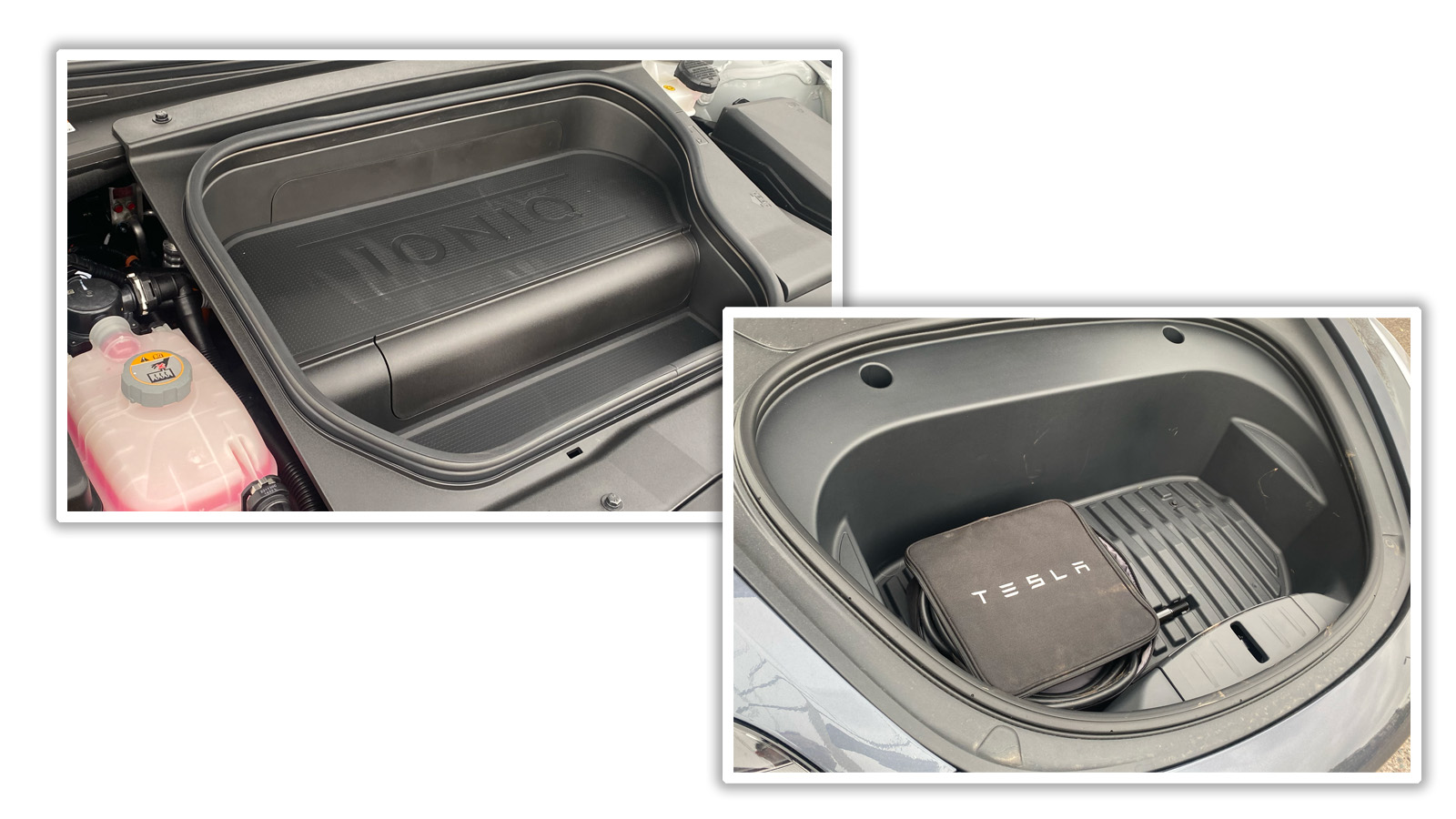
But, of course, in this case, the comparison isn’t totally fair, because that Tesla frunk up there is from the single-motor car, and as such has more volume to play with. What about the single-motor Ioniq 6? Shouldn’t that be able to carve out more frunk room?
Well, the answer is yes, but, maddeningly, only if you don’t live in America. For some inane reason – I think maybe that regulation designed to keep kids from somehow getting crammed in trunks – both the single- and dual-motor Ioniq 6s have the same shallow trunk for U.S. market cars, while global market cars enjoy a much deeper front trunk. Look, I found a picture and everything!

Look at that! It’s like over twice the volume of the one we get! This is a crime! A crime, I tell you! Can’t they just shove in a removable anti-toddler divider like all those supercar makers use? Come on, Hyundai.
The interior materials are interesting; a lot of it uses what seems to be a recycled plastic with a textured surface that resembles a textile like canvas or linen. It’s a kind of material that, while not necessarily overtly “premium,” is one I’ve come to associate with some types of interesting low-volume arty objects I’ve encountered over time, and so I have a set of positive associations with how it looks and feels.

My driving partner didn’t agree, and didn’t like the material. This may be one of those tactile things that you’d have to decide for yourself; whatever you think of it, it seems durable and hard-wearing, so that’s a plus. That double-decker center console is interesting because I was told by a designer that those side “rails” are designed to be higher than what’s between them so you can set a laptop across the top, using it like a desk.
What is in between them is something that I’m less fond of: the window controls.

If you’re not going to put the window controls on the doors, there should be a damn good reason, like you can take the doors off or you have a manual shifter that the driver’s hand is near, anyway. Otherwise, it just feels wrong. My fingers kept fumbling around on the armrest for buttons that were not there. I suppose you could get used to it, but why should you, dammit?
Well, since we’re on the subject of switches, I guess we can go ahead and jump right into this:
Interior Gadgetry
You know what may be the most interesting thing that’s not on the dash of the Ioniq 6? It’s what would have gone here:

See that odd little wing/wall thing on the side of the dash, with that big flat plastic panel on it? It’s an interesting looking design choice for the sides of the dash, isn’t it? That’s because it was intended to be something else; specifically the place where the screens for Hyundai’s Digital Side Mirrors would go:
Clever visibility anytime with the “Digital Side Mirror” of the new IONIQ 6. The cameras and OLED displays integrated with the dashboard offer a clearer, wider view than conventional side mirrors.#IONIQ6 #ElectrifiedStreamliner #AwakenYourWorld #Streamliner #EV #Hyundai #IONIQ pic.twitter.com/yDKKBYfp5I
— Hyundai Worldwide (@Hyundai_Global) August 16, 2022
Camera-based side mirrors are not legal in America currently, so where the rest of the world has little camera-based side mirrors, we have old-school mirrors. While this does cost the US-spec model a bit of an aero hit (0.22 Cd instead of 0.21), personally I’m glad we don’t have them for two reasons: one, I don’t think screen-based mirrors work as well as physical mirrors (I’ve addressed this before) and, also, there’s just something about adding the complexity of an electronic component like a camera to replace a dumb, cheap mirror that does the same job without power or anything that rubs me the wrong way. Sure, there are aero advantages, but do those compensate for the power draw of the cameras and screens? Maybe? I don’t know. Anyway, we don’t get those here, so find a sticker you like for that little gray slab.

The instrument cluster is, as you no doubt expect by now, an LCD screen, of about the same size and aspect ratio as the center infotainment screen. Both are large and bright and very high quality, but Hyundai doesn’t expect you to do everything on the screens, which I appreciate. There’s a physical volume knob and physical and separate touch climate/HVAC controls.
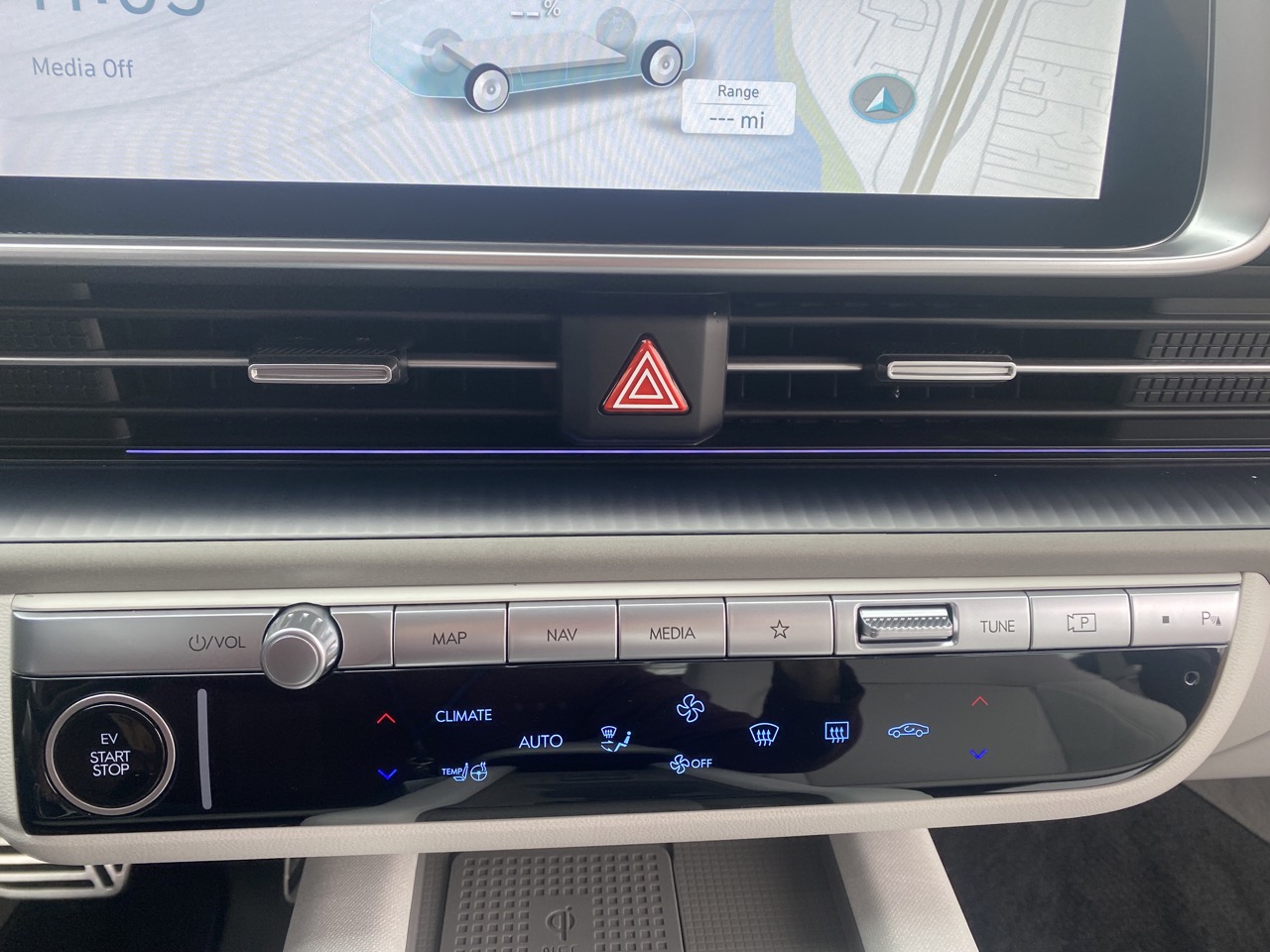
I may have wanted more tactile HVAC controls, but at least these are always present and in the same, expected place. They worked well and in obvious ways, which is what you really want out of something like your climate controls. There’s a little row of other commonly-used functions on physical buttons, and the vents use simple and expected physical sliders to direct the air or to close/open them. Good. This just works. There’s no good reason to navigate an on-screen menu to be able to blow cold air on your crotch in the summer.

The shifter is a column-mounted stalk, but not quite like the one on your old Pontiac Bonneville; you pick which direction you want to travel by rotating the end there. It works, and it’s nicely out of the way.

Hyundai’s designers also made a big deal about how they eliminated the company’s badge from the steering wheel center, since you probably know what you’re driving already. They replaced a logo with four lights (four dots is also “H” in Morse code, so there’s an Easter Egg) and those lights give the driver a bit of information, such as when the car is using assistance like dynamic cruise or lane keeping, as well as indicating charging status when plugged in. I like it.
Moving on, do you know what Hyundai/Kia does better than almost anyone else? Wiper controls. Look:

When you move the stalk, you get this little pop-up window that tells you what your wiper setting is. Most cars just rely on you knowing which notch you’ve set the stalk to, which is often hard to tell. Why doesn’t everyone do it like this? It’s great.

The interface design for the instrument cluster is pretty legible, even if the 3D, receding-into-the-dash bar graphs laid out like an open book feels a bit arbitrary. The speed and range are clearly visible at a glance, so that’s good, at least. The instruments change look based on the driving modes, Eco, Normal, and Sport. Here’s Sport, which turns the highlight color a more lusty red:

You can also use Apple Car Play or Android Auto as an alternate infotainment system, unlike Teslas or possibly some other brands in the near future. It is, however, only available when the phone is physically plugged into the USB port via a cable, not Bluetooth. One day I need to sit down and figure out why some carmakers are able to connect to Car Play or Android Auto wirelessly and some aren’t, or don’t.

Oh, and our podcast will be starting again soon, just so you know.
Oh, and speaking of weird sounds that can come out of your car, the Ioniq 6 does make replacement noises for the lack of engine sounds while driving, and they’re generally Jetsonian and inoffensive, providing a nice bit of audible feedback when you accelerate. There is also ambient lighting that can change while you drive, but I didn’t really get a chance to drive the car in darkness, so I can’t tell you if that’s a fun experience or not. I mean, it sounds kinda fun?
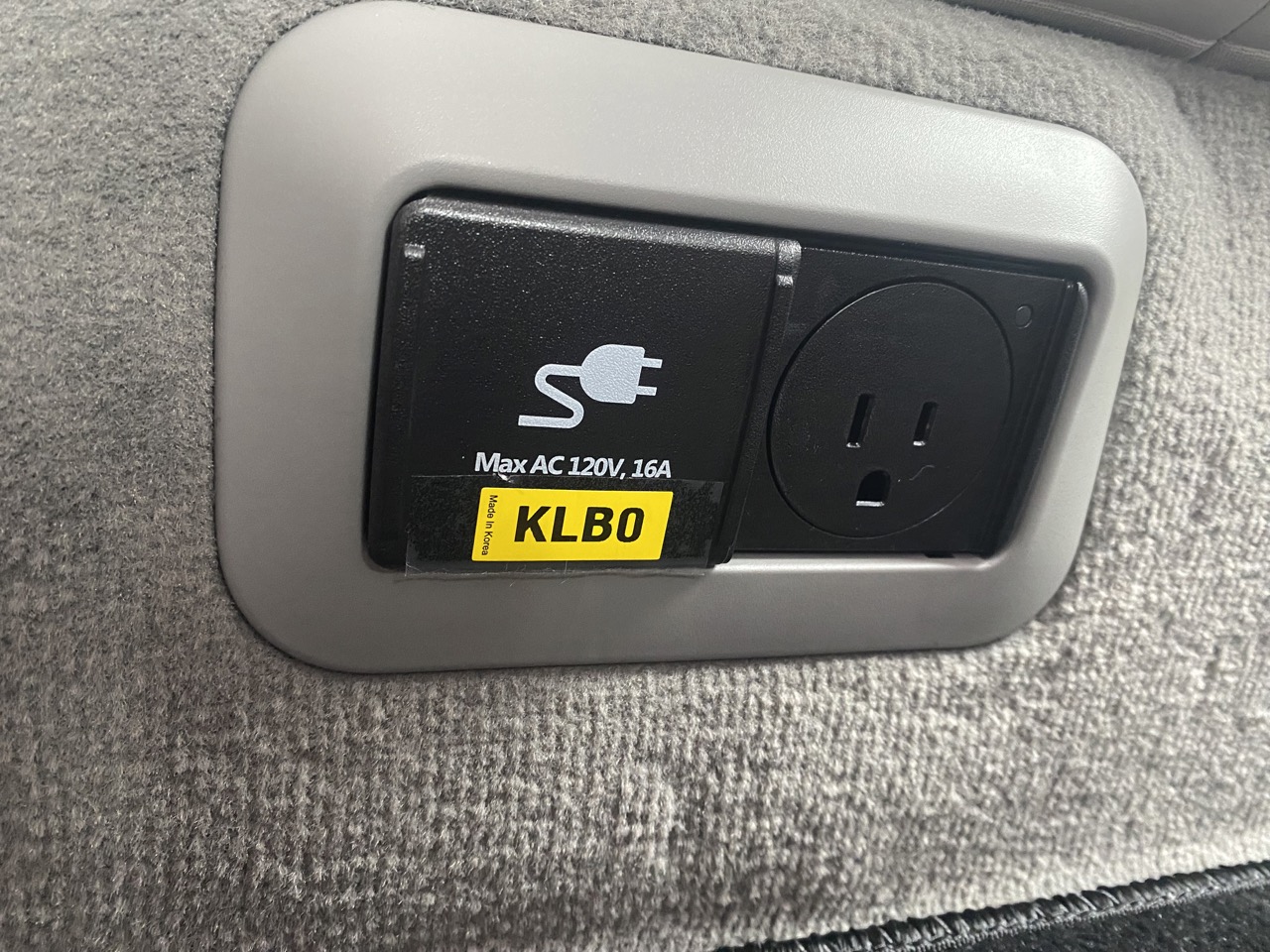
In addition to the expected USB A and C ports in the car, there’s also a 120V wall-type outlet under the back seat that can be used for, well, most stuff you plug in. A toaster, maybe. A Vitamix. A massager. I was told by one of the engineers that his team (briefly) ran a welder off the socket! And also a refrigerator for five days, with, they claimed, minimal drain on the battery.
What It’s Like To Drive The Hyundai Ioniq 6
I suppose were you to hold me at knifepoint and demand that I pick one word to describe the driving experience of the Ioniq 6, my first reaction would be to be gravely concerned about your mental state and perhaps suggest you seek out therapy or the counsel of a trusted clergyperson. Were you to persist, I think I’d pick the word “pleasant,” because, well, it generally is a pleasant experience.
It’s an easy car to drive; the suspension feels more tuned for comfort than outright performance, and compared to what is arguably the Ioniq 6’s biggest competitor, the Tesla Model 3, it’s not as quick and has a softer, less harsh ride. It’s less performance-oriented, and for most of the people likely to buy one of these, that’s probably fine.

That’s not to say that it’s not quick; in Sport mode, electro-throttle response changes dramatically, and the Ioniq 6 pulls hard and feels genuinely quick. Not Tesla Model 3 quick, but still pretty damn good. It’s really easy and comfortable to drive at highway speeds, and would make an ideal road trip car were it not for one huge issue that’s not really the fault of the car itself: the lack of a truly reliable and widespread charging network.
That’s really the biggest advantage of a Tesla in this context; its Supercharger network is quite well established and generally a known quantity. Sure, Hyundai’s Electric-Global Modular Platform (E-GMP) allows for 800 volt, 350 kW charging that can go from 10 to 80% charge in 18 minutes — a fantastic achievement — but only if you can find a charger that can accommodate those kinds of speeds.

(As an aside, I think most EV-makers are using some fun little symbols on their EV pedals now. This time it’s not play/pause, it’s + and -. Maybe we’ll get the hand for stop and a walking guy next?)
Currently (crap, is that a pun?) Hyundai is partnered with Electrify America, and their network isn’t as robust as Tesla’s, both in number of stations as well as the maintenance and reliability of those stations. The Ioniq 6 will pre-heat and prepare the battery for optimal charging when it knows you’re on the way to a charge station, but this only helps if you can find a properly equipped station to use.
If you’re charging primarily at home every night, this is less of an issue, but Hyundai has built a car here that’s roomy and quiet and comfortable and has an impressively long battery range (361 miles for the longest rated version) and by almost every metric would be a terrific long-haul cruiser – if you know you can easily find a place to charge it on your road trip.
I’m hopeful the charging network will continue to improve. While we’re waiting for that to happen, I can tell you about what I think is the Ioniq 6’s most novel driving feature: its paddle shifters.
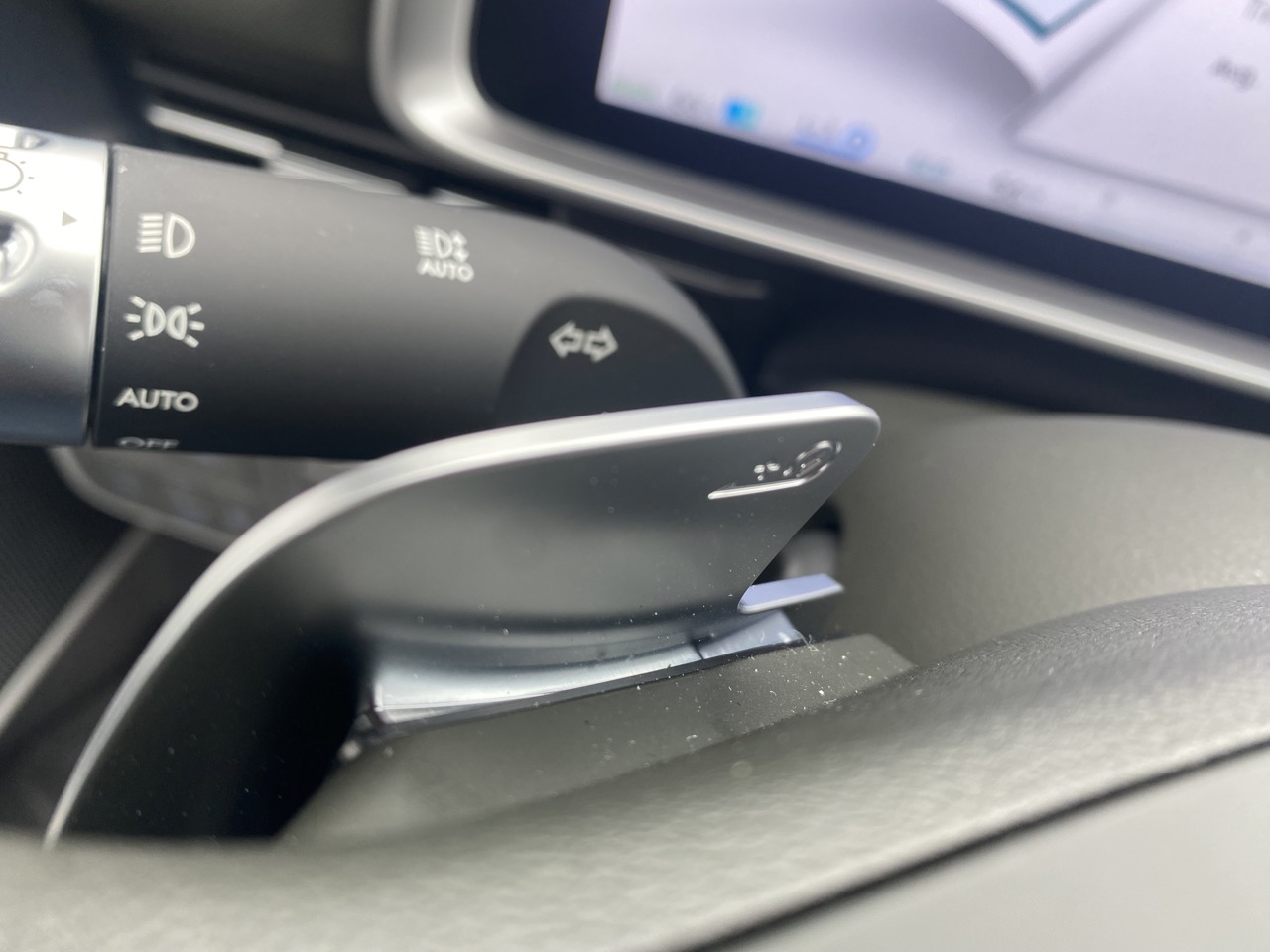
Now, I know what you’re thinking: Jason, you idiot, there are no gears to shift here! And, don’t you hate paddle shifters? Well, not exactly. I think most conventional paddle shifters don’t get used very much, and yes, there aren’t any gears to deal with here. In the case of the Ioniq 6, the paddles adjust the brake regen settings, and I think it works really well.
The Cadillac ELR and the Chevy Volt and the VW Golf Blue e-Motion EV also have paddles that adjusted regen, but I’ll be honest and tell you I do not remember what the experience using those was like. What I do know is that on the Ioniq 6, the paddles can switch the level of electric motor regeneration between five levels, with the most aggressive setting providing one-pedal driving and enough regen to quickly bring the vehicle to a stop, and the other extreme setting allowing for truly freewheeling coasting.

In fact, there’s actually a special dog clutch connected to the front motor unit (when present, of course) that can entirely disconnect the motor from the wheels, which engineers told me can give up to a six percent increase in economy.
What I liked about the paddle regen controls was the ease of adjustment – most other regen systems on EVs I’ve driven have required some sort of screen-and-menu system to adjust these settings – and how that ease encouraged active use of the regen settings to make driving more efficient and engaging. For example, while I still need to actually have an engineer walk me through all the math, there are times when just actually coasting freely is more efficient than using regen to generate electricity to put back into the batteries.
On a long, straight road with a slight downward incline, it just feels better to glide along and coast, and then when you need to slow down, upping the regen is a great way to do that. Sure, there is an onboard auto-adjusting regen system that uses the radar sensors and is likely quite efficient, but I found the active use of the paddles made driving a bit more fun and engaging, so what’s not to like about that?
If you feel like handing off some of the driving duties to the car, you lazy bum, then Hyundai can help, with a Level 2-ish semi-automated driving system called Highway Driving Assist, and the latest version of that can change lanes if you suggest doing so by turning on the proper indicator.
Some Tech Talk
The Ioniq 6 is built on the same E-GMP platform as the Ioniq 5 crossover, the Kia EV6 and the Genesis GV60, all of which are taller vehicles. The use here in a sedan context is an interesting demonstration of the flexibility of the platform. It’s a skateboard-type platform like most other EV platforms, and while the battery pack is in the floor, unlike some other platforms, it isn’t a structural, stressed component. 
I know some may consider this a less elegant way to design EVs, but it should make removal and replacement of the battery pack a less invasive procedure; the engineer I spoke with generally agreed, and that same engineer also described how the lithium-ion cells looked in their modules by describing them as being “like Pop Tarts,” which I found very evocative. There are two of these electric Pop Tart battery packs available, a 480 volt 53 kWh one and a larger 697 volt 77.4 kWh one.
The cooling of the battery pack is handled by serpentine channels of coolant flowing below the battery modules, as opposed to Tesla’s cooling channels, which are more integrated throughout the internal cylindrical cells of the battery pack. In discussing the battery cooling system with an engineer, I was most struck by an interesting reality of electric car engineering: heat is a resource.
In the combustion car world, heat is plentiful, and most of the effort is simply spent trying to expel heat from the system, at least usually. In EVs, there’s a lot less heat to be had, so the heat generated by various systems is carefully monitored and, where possible, routed to places or systems that need the heat, such as batteries for thermal management or such as the cabin, for keeping the people inside from freezing.
I’d never really thought of heat as a precious resource in a car’s powertrain, but it very much can be thought of like that.

Suspension-wise, the Ioniq 6 has MacPherson struts up front and a multi-link setup at the rear. The steering is rack and pinion, and allows for a 38.8 foot turning circle, which felt pretty tight.
Pricing, Options, and Final Thoughts
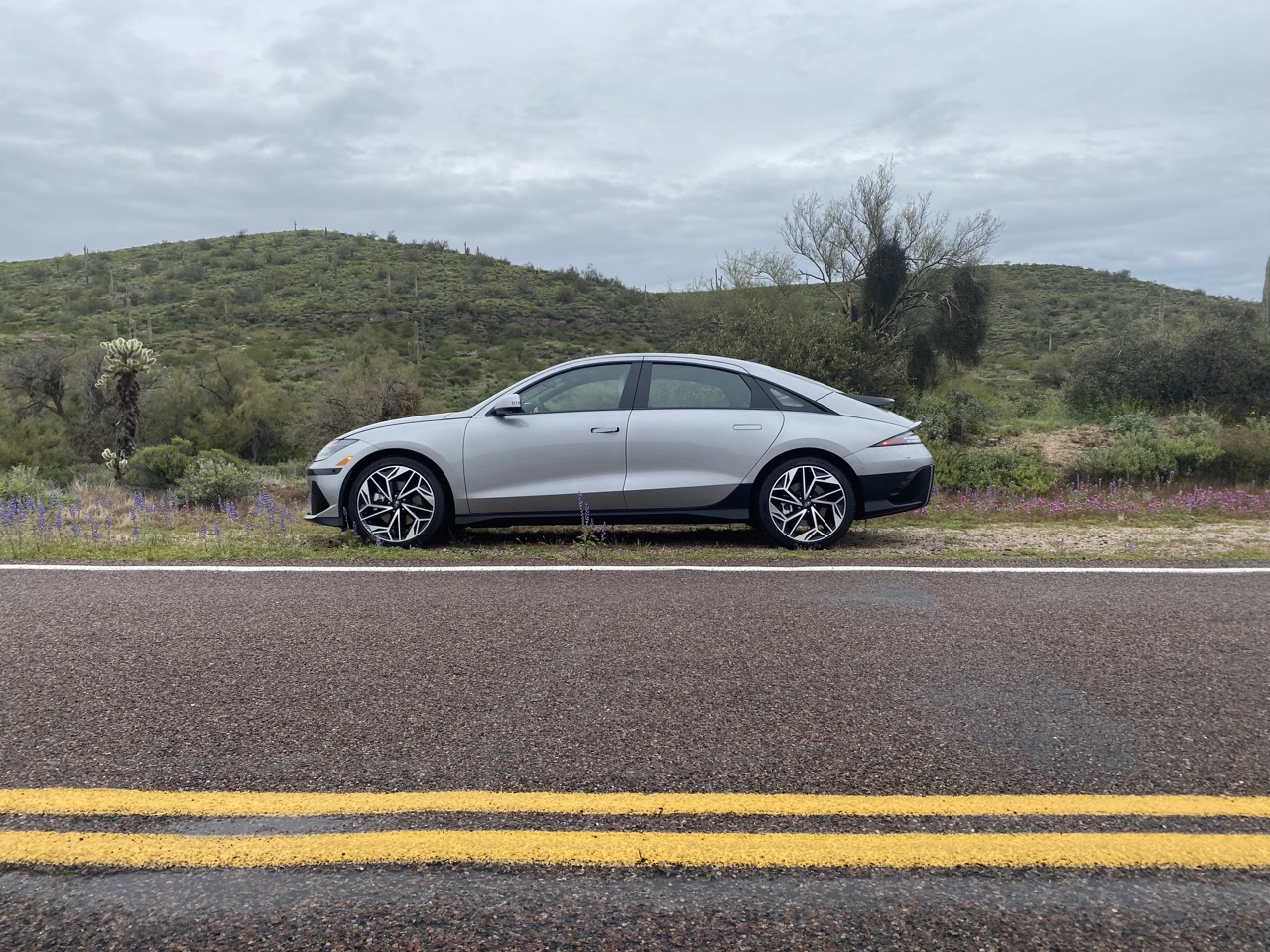
Here are all the ways Hyundai will sell you an Ioniq 6, and how many of your dollars they’ll want in exchange:
| IONIQ 6 Trim Level | Electric Powertrain | Drivetrain | Driving Range | MSRP |
| SE RWD Standard Range (18-inch wheels) | 149HP rear motor | RWD | 240 miles | $41,600 |
| SE RWD Long Range (18-inch wheels) | 225HP rear motor | RWD | 361 miles | $45,500 |
| SE AWD Long Range (18-inch wheels) | 320HP dual motor | AWD | 316 miles | $49,000 |
| SEL RWD (20-inch wheels) | 225HP rear motor | RWD | 305 miles | $47,700 |
| SEL AWD (20-inch wheels) | 320HP dual motor | AWD | 270 miles | $51,200 |
(By the way, this chart can get cut off on mobile, so here it is as a graphic:
For me, I think the sweet spot is the RWD 225 hp one with the 361 mile range for $45,500; that’s really only about average price for a modern car, and a lot less than the average transaction price for an EV, which is almost $60,000. For your money you get a non-boring-looking, comfortable, premium-feeling electric four-door sedan that has a lot of character and a great interior.
The charging network isn’t at the level of Tesla’s Supercharger network, and the Model 3 is a better performer, but there’s something I preferred about the Ioniq 6, and it’s not really something you can quantify. This feels like an optimistic car, and somehow conveys less, I don’t know, arrogance than a car like a Tesla. It has its own very specific style that’s not for everyone, but I suspect that there are plenty of people who will appreciate it, and appreciate it a lot.
Just see if you can get the bigger global market frunk, somehow. We deserve it.

- Rhode Island Tops The List Of Most Chaotic States To Drive In
- Here’s One More Reason Why Owning An Automatic Dodge Dart Might Be The Opposite Of Great
- The Slate EV Pickup Truck’s Chance At Success Just Took A Huge Hit
- Enthusiast Produces Film About Everything Audi Is Doing Wrong, Car Community Triggered in Solidarity
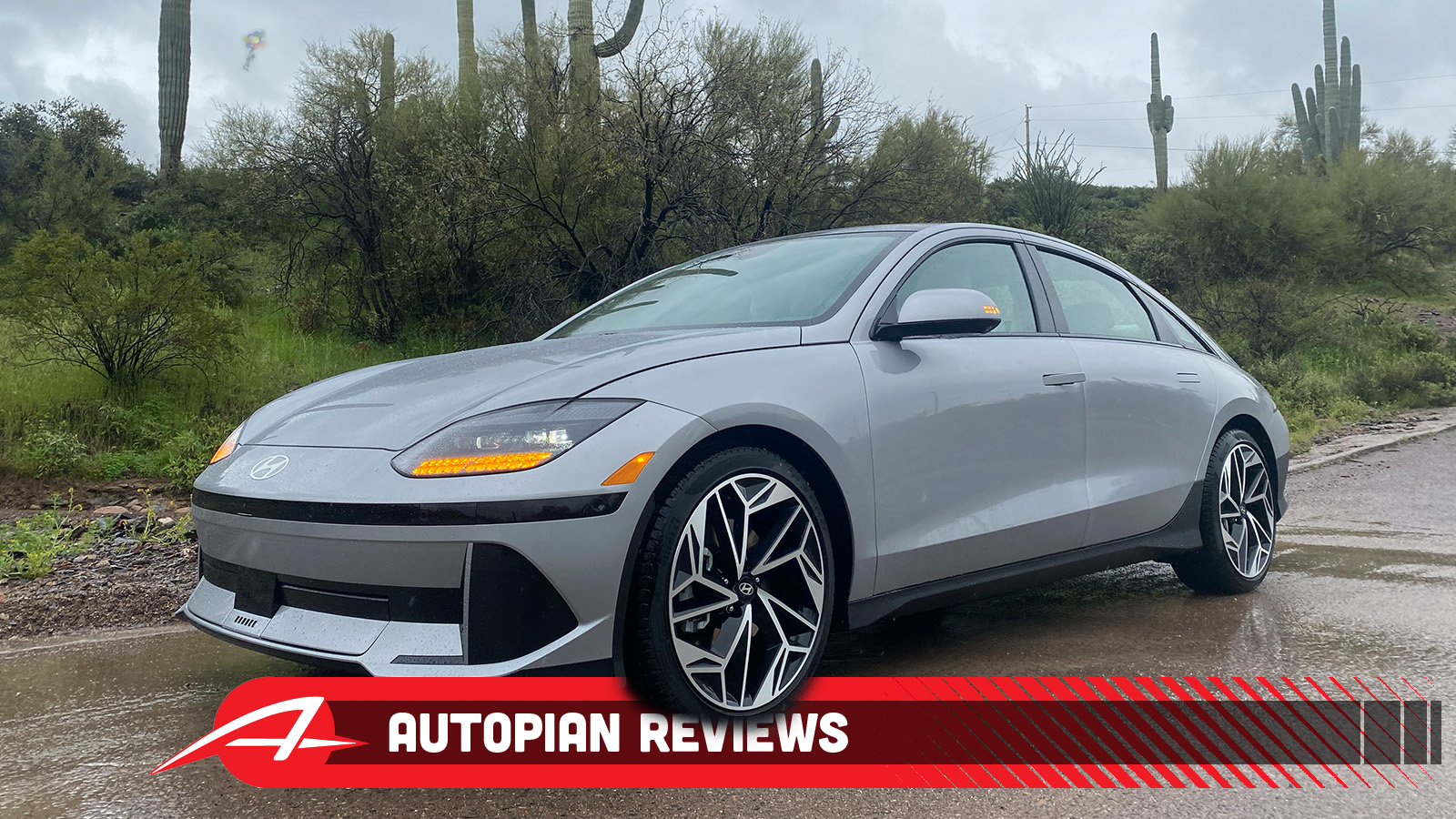









I don’t know much about cars in general, but the first impression I got was modernized Citroën.
Thanks for a great review about an interesting car Jason… I also enjoyed your quick video… your hair looks fine… don’t let anyone tell you otherwise.
Though I’m in the market for a used EV and not a new one at the moment (and will probably wind up with a non-REX BMW i3, all things considered) I really like both the Ionic 5 and 6. I like that they’re not huge (like the Ionic 9 or whatever Telluridish EV they’re about to release) and I like that they’re easier on the eyes on the Niro/Kona.
In a perfect world, the Ionic 6 would also be available as a wagon (an unlifted, unoffroady one… just a real/regular wagon) and while I’m wishing for things that’ll never happen, I’d prefer that said wagon were ONLY available in non-metallic colors: say, Tiffany-box blue, some sort of sweet dark green, etc…
You glossed over my one beef with this car so far: capacitive touch climate control buttons. I really wonder how the teams that select that option make it through winter testing. I experienced an older Explorer with those, and it was maddening trying to make adjustments in the winter before the cabin fully warmed up because you’d have to take your glove off, adjust, put the glove back on, rinse and repeat. There’s a reason Ford ditched that control method ASAP, and now companies have brought it back with the touch screens. Hyundai snatched defeat from the jaws of victory here: they had a separate panel for HVAC controls, and could have put physical switches (that you could also operate by feel without pulling your eyes off the road) and went with a glossy flat expanse that requires bare skin to operate. For shame. SHAME.
Let me preface this with that fact that I’m not a Tesla fanboy. The charging infrastructure is really a massive advantage that nobody else even seems to be trying to tackle. I posted a video of Ryan Shaw taking his Rivian on a road trip and it shows how unreliable third party charging is. I’ve driving my Tesla from SF to LA several times and there was never any issue at all with charging.
https://www.youtube.com/watch?v=1Nl45g8Q-_g
Now having said that, I already own an EV that I can take on a road trip, so my next EV can be anything.
Thank you for calling out the paddles! Kia and Hyundai have the best regen strategy in the industry in my opinion.
My only complaints for their EVs are the lack of USB-C ports (major) and the direction of the increment decrement for the radio channel button (minor nitpick).
Eeeegad. That’s not a handsome car.
No, it’s not handsome. It’s gorgeous.
I want one. This seems like a car that could genuinely be useful on a road trip, not just puttering around the city. I hope these sell well down under so I’ll be able to afford a lightly used example in a couple of years. Please someone a bit wealthier in Adelaide, buy a RWD, long range model please! I’m not fussy what colour you get.
I like the central window switches – they are very Holden Commodoresque. I think Holden did it as a cost cutting measure to make LHD versions for export cheaper to hack together. Don’t know what Hyundai’s excuse is.
The center mount window switches are very 80’s-90’s Mercedes-Benz…
I just want to say… now that is a comprehensive car review. Other websites hardly bother to review cars this well.
Yeah same. Plus I know the owner isn’t some corporate shill, it’s instead some nutjob obsessed with the historical development of taillights, and that’s why I come here.
Exactly. Nutjobs like Torch write great reviews.
The BMW driver in me rejoices to see the center-console window controls. One of the things I dislike about my E82 is that they moved the window controls to the doors instead of either side of the gear lever like God and Claus Luthe intended.
My old MBZ has those too. They’re fine. Not really something to be worked up about IMO.
My first car and long-time daily driver was a Mazda MX-5 NB, now delegated to summer joyride machine.
Still, my hand instinctively moves to the center console to lower the windows in everything I drive.
I suspect the overseas market front trunk tubs will become popular conversions, just like how people like to install back seats in their late model US Karmann Ghias
Yeah, there’s definitely going to be a niche market for overseas add-ons for the Ioniq 6
Looks like a Wish version of a Porsche Panamera, in the grand tradition of Hyundai copying other makers homework.
I don’t have much to add other than great article and writing, and that intangible ‘something’ is so important. It’s kind of why I don’t care about most new cars. I just don’t. Give me a winning lottery ticket, and I’ll still likely drive 80s/90s hondas most of the time, and vintage stuff on the weekends. Wait. 80s/90s hondas are now vintage too. fml.
For me, it’s b/c cars like this seem to increasingly deprioritize the human – machine connection. You’re not in control of it so much as you’re consuming it (and the driving experience) as a product tailored to your desires.
I wonder if vehicles like this signal automobiles becoming as mobile phones are now. Few people love their phone as a thing in itself, they love it for the experiences it provides; so it’s something to throw away when an upgrade is available, not something to cherish, fix when broken, etc.
This is exactly it. This review feels weird to me because there’s nothing really hate-worthy about this car, I’m sure it’s an excellent appliance, but there’s just very little emotion to it. The interesting styling gives it some character, but even then, would the lack of a driving experience be worth it? I don’t know. I feel like we as humans have been worshipping the concept of perfection, to the point of sacrificing character for numbness. Experiences have benefits and drawbacks, and it seems like people don’t want to feel anything anymore. There’s no concept of the benefits of a thing being worth the drawbacks. EVs like this are generally fine, but the experience stops there. I just feel like life’s too short not to feel things.
I think there are a few reasons for that:
Many such “experiences” are ever increasingly sanitized, monetized, scripted packages to be bought and sold rather than something that simply happens. A chance meeting with a stranger who is genuinely friendly and interested in getting to know you is wonderful – meeting a stranger who is not genuinely friendly and interested but pretends to be because that’s the job and they want your money is just sad.
As cars go there’s also the fact cars are far more capable than they’ve ever been. I think many this is diminishing the returns on the thrills. You were HAPPY when you turned the key and the car actually sputtered to life! You were scared and pissed when it didn’t. Now cars always start so you don’t get those emotions.
It also doesn’t help when you’re driving a car with performance that used to be the realm of the supercars of your youth when the roads are crowded, in poor shape and there are fewer convenient nor cheap sanctioned locations to explore the full potential of the car. Might even make you wonder why you bought a Hellcat.
I guess the solution there is to find your bliss. Just please do so (not you specifically) without being a burden to others. If your thing is rush hour bridge takeovers or loud AF exhausts you need to find another way to get happy. Try hiking.
You and awesomeaustinv both hit on something I’d been thinking too, that our (not us specifically) relationship with cars is becoming lopsided; cars are way more capable, but we’re ever less so.
Back in the ’80s for instance, one had to work at it to be able to handle a performance car. To unlock its capability, one had to become capable as well, and the potential penalties for NOT having that match were much higher as there was no ABS, traction control, etc. A car like a Porsche 911 could be genuinely scary, and to have mastery of something like that was therefore impressive. It was less about the car than about driver.
Now, for a lot of people, it’s about the car; once they’re in over their head, the car comes to the rescue. And it’s a probably a good thing on balance, but it does rob us of some agency and a chance for excellence.
A car like a Porsche 911 IS genuinely scary
FTFY. I drive mine pretty conservatively. Snap oversteer is real and terrifies me. Have experienced it once, saved it, not sure I will be that lucky every time.
I think there’s something else, that isn’t really a metric: Response/nimbleness/agility. Today cars are reviewed by the acceleration, the grip of the skidpad, and maybe even a 600 foot slalom (more grip, really), but what they aren’t getting down to numbers is response.
All the old 80s/90s shitboxes I drive are admittedly deathtraps, but they have AMAZING visibility that isn’t possible with today’s safety standards, and AMAZING response because lack of mass. My vintage 911 is sort of the same thing, except all the mechanical noises and interactions feel more like a well oiled weapon, but raw and mechanical.
A new camry will blow the doors off from either of them in terms of performance, but it won’t FEEL as fast. Maybe it’s because I’m 40 now, but I don’t give a single shit about metrics, it’s all about the experience, and the feeling.
I have said it before many times.EVs are fine. Many people who look at the automobile as an appliance to get from point A to point B will love EVs.
But, and this is a huge but for most Autopians…….they have no soul.
I have ridden in several EVs. Sure, some are fast (Model 3 Performance) most are serviceable transportation (Bolt), but they all lack the soul you get from ICE. Yes, NVH engineers will love EVs as there is little of that to worry with, but those shakes, sounds, vibrations and intangibles are what gives a car soul. And, while I agree with Jason, design will become more important with EVs, it will never give the car soul when there are 100K cars produced every year that look the same.
As the 3 gets some competition, it makes it tough to see why anyone would want the Tesla. It feels like the 6, with 800v architecture and bidirectional charging, is a generation ahead of the 3. It took how many years for the 3 to show up? Tesla remains slow when it comes to new product release. GM, Ford, and now Stellantis, will have trucks in production before Tesla gets the Cybertruck out the door.
Tesla has to compete with real carmakers now and they appear to be losing ground rapidly. Ford is already working on their second gen F150/EV truck and expects to have it in production in two years.
Tesla appears to be running the same playbook that almost led to Detroit’s extinction: get beat on content, then get beat on stale product while you’re getting beaten on price, all the while, claiming that you know better than the customer when it comes to their true wants and needs.
Time will tell, but it’s not looking good from a market perspective for Tesla, exactly due to challengers like Hyundai/Kia and, increasingly, Ford of all companies.
It feels like back when IBM introduced the IBM PC, kinda sat on it for a few years, releasing the AT and not much else, which allowed PCs Limited (Dell) and a whole host of other competitors to gain market share and eventually end IBM’s personal computing line.
I’m not a fan of Tesla, but it will be very hard for other makers to beat them on price. Their innovative production techniques and vertical integration keep their costs way down. For now, they charge more because they are supply constrained and can charge what they want. When they have competition they can drop their prices much more than other makers while remaining profitable.
I agree with the rest of your post, though.
I agree with your points except maybe the being beat on price. Tesla has the production cost edge for the foreseeable future. Their margins are among the highest in the industry and definitely for the EV industry. This does come at a quality hit and they aren’t utilizing it as much as they can but, with the recent Tesla and Ford price cuts, one is still making money and one is losing money on EVs still. https://www.theautopian.com/ford-plans-to-lose-3-billion-this-year-building-electric-cars/
Sorry,
but one thing they have in common is they are BUT FUGLY. Put them both together at the wheels and you have a picture of my morning #2.
Consider discussing this with your PCP
On the wiper settings showing up in the dash, on our 2022 Nissan Rogue, it comes up in the middle of the driver’s display for a few seconds, then goes away. It is nice for telling what level you have the delay set at.
I think on the window buttons in the middle it is something that you get used to over time. Some of the Mercedes had this feature as well.
Center window switches have the advantage that the passenger can annoy the driver by opening their window during a freezing blizzard.
The rear headroom is a big let down. Also, since I use every bit of the Sonata leg room up front, not sure how this will feel in the front seat either. I do remember kind of fitting in a Model 3 but I never drove it so almost anything is fine for a few minutes. If I stay with the brand for an EV, Ioniq5 would be the winner because I know I can fit front and rear. Kind of a bummer since I have been watching for this since the Prophecy, was let down by the real vs concept styling (still like it though) but the interior space is a bust for this tall, family guy.
Having grown up driving 80s Audis with the window switches on the center console, I have to respectfully disagree with your assessment. This location makes perfect sense and has the added benefit of reducing parts count by at least one switch. Why does the passenger need their own? What are they, too good to share with the driver? And do we really want the switches to be in a location that will get dripped on any time you need to open the window or door when it’s raining?
If you plug your car in at say, the hotel charger for the night, does it send a ping to your phone when it’s done so you can move it and let someone else have some juice?
I’m pretty sure it does/can. Even my 2019 Niro PHEV can do that, and I can’t imagine that Kia/Hyundai have gotten worse at that, especially on a full EV.